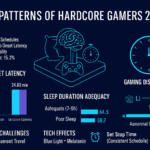Do Video Games Cause Violence?
The question of whether video games cause violence has persisted for decades, sparking heated debates among researchers, policymakers, and parents. Recent longitudinal studies from 2025 provide more nuanced insights into this relationship, examining thousands of adolescents over extended periods to separate correlation from causation.
This analysis examines high-quality empirical evidence from three major 2024 studies involving over 18,000 participants. The findings challenge common assumptions about violent video games and aggression while revealing complex patterns that vary by age, gender, and gaming behavior.
Understanding Video Game Violence Research Design
Before examining specific findings, understanding research methodology proves essential. Studies measuring violent video game effects employ different approaches that yield different types of evidence.
The most robust 2024 research includes a Czech longitudinal study tracking 3,010 adolescents across four waves spanning 18 months. This cross-lagged panel design allows researchers to observe how changes within individuals unfold over time, rather than simply comparing different people at a single point.
The Czech study represents one of the strongest designs for understanding causation in video game research. Unlike cross-sectional surveys that capture a snapshot in time, longitudinal tracking reveals whether increased gaming precedes behavioral changes or whether pre-existing traits predict gaming choices.
Additional 2024 evidence comes from a cross-sectional study of 304 emerging adults and a French survey of approximately 15,235 adolescents. While these studies cannot establish causation, they identify important associations between gaming patterns and various mental health indicators across large populations.
Between-Person vs Within-Person Analysis
A critical distinction in interpreting results involves understanding between-person versus within-person effects. Between-person analysis compares different individuals, asking whether people who generally play more violent games differ from those who play less.
Within-person analysis tracks the same individual over time, examining whether increases in violent game exposure within that person predict subsequent changes in aggression or empathy. This approach provides stronger evidence for causal relationships.
Video Games and Aggression: What 2024 Data Reveals
The Czech longitudinal study provides the most detailed evidence on whether violent video games cause aggression. Results distinguish clearly between correlation and causation.
Correlation Does Not Equal Causation in Video Game Studies
At the between-person level, adolescents who generally played more violent video games showed higher verbal aggression (β ≈ 0.30) and physical aggression. This correlation appears in multiple studies and often fuels concerns about gaming violence.
However, the within-person analysis tells a different story. When tracking individual adolescents over time, increases in violent video game exposure did not significantly predict later increases in either verbal or physical aggression. The desensitization effect that many feared appears negligible in this rigorous analysis.
More surprisingly, the data revealed a selection effect operating in the opposite direction. Adolescents with higher physical aggression in one wave were more likely to increase their violent video game consumption in the next wave (β ≈ 0.12). This suggests that aggressive individuals gravitate toward violent content rather than violent content creating aggression.
Emerging Adult Patterns in Gaming and Aggression
The emerging adult study (ages 18-24) found moderate positive correlations between game violence ratings and aggression (r ≈ 0.30). However, this cross-sectional design cannot determine whether gaming causes aggression or whether individuals with higher baseline aggression prefer more violent games.
Problem gaming behavior emerged as a significant mediating factor. The relationship between violent content and aggression appeared stronger among individuals exhibiting addictive gaming patterns or excessive engagement rather than among casual players of similar content.
Do Video Games Reduce Empathy?
Concerns about violent video games often extend beyond aggression to questions about empathy. The 2024 evidence provides unexpected insights into this relationship.
Longitudinal Evidence on Gaming and Empathy
The Czech study measured both affective empathy (emotional responses to others’ feelings) and cognitive empathy (understanding others’ perspectives). Surprisingly, adolescents who played more violent games showed slight positive correlations with cognitive empathy at the between-person level.
More importantly, within-person analysis found no significant decline in either form of empathy as adolescents increased their violent video game exposure over time. The feared desensitization to others’ suffering did not materialize in this longitudinal tracking.
In fact, adolescents who increased in affective empathy during one wave subsequently decreased their violent video game consumption in the following wave (β ≈ -0.12). This selection effect suggests that empathetic individuals may naturally drift away from violent content.
Cross-Sectional Empathy Findings
The emerging adult study found a moderate negative correlation between game violence ratings and empathy (r ≈ -0.41). While this appears concerning, the cross-sectional design cannot distinguish whether gaming reduces empathy or whether individuals with lower empathy prefer violent games.
Given the longitudinal evidence showing no within-person decline in empathy despite increased gaming, the latter explanation appears more plausible. Trait-level differences in empathy may influence game preferences rather than games altering empathy levels.
Mental Health Outcomes and Video Game Violence
The French adolescent study examined associations between violent video game use and various mental health indicators, revealing important gender differences.
Gender Differences in Gaming Effects
Among female adolescents who played violent video games, significantly elevated rates of depression (22.3%), suicide attempts (22.8%), and self-harm (17.8%) emerged compared to non-violent gamers or non-gamers. These differences proved substantial and statistically significant.
Male violent gamers showed less pronounced associations with these mental health outcomes. Depression and suicide attempt rates did not differ as dramatically from non-violent gaming males, though a small association appeared for self-harm behaviors.
These gender-specific patterns suggest that female adolescents may be more vulnerable to negative mental health correlates of violent gaming. However, the cross-sectional design cannot determine whether gaming contributes to mental health problems or whether adolescents experiencing mental health struggles gravitate toward violent games as a coping mechanism.
Problem Gaming as a Key Factor
Across multiple studies, problem gaming behavior emerged as more predictive of negative outcomes than violent content alone. The emerging adult study found that game violence rating correlated strongly with problem gaming (r = 0.47), and problem gaming mediated relationships between violent content and both aggression and reduced empathy.
This suggests that the intensity and compulsiveness of gaming may matter more than specific content. Individuals who game problematically show poorer outcomes regardless of whether they primarily play violent or non-violent titles, though violent content appears more frequently associated with excessive engagement.
Age and Developmental Factors in Video Game Effects
The Czech study examined age-related differences in how violent video games relate to behavior, finding that younger adolescents showed different patterns than older teens.
Selection Effects Stronger in Younger Adolescents
Younger participants (ages 11-13) showed stronger links between physical aggression and subsequent violent video game consumption than older adolescents. This suggests that selection effects may operate more powerfully during early adolescence when gaming preferences are still forming.
As adolescents mature, their gaming preferences appear more stable and less reactive to behavioral changes. This developmental pattern suggests that interventions focused on gaming content may be more relevant for younger rather than older teens.
Cognitive Development and Media Interpretation
Younger adolescents may process violent media content differently than older teens or adults due to ongoing brain development, particularly in regions governing impulse control and emotional regulation. However, the 2024 evidence suggests this vulnerability manifests more in who chooses violent content rather than in how that content affects them.
The lack of significant within-person desensitization effects even in younger cohorts suggests that adolescent brains may be more resilient to gaming content than commonly assumed, though individual differences remain important.
Do Video Games Cause Real-World Violence?
Perhaps the most important question involves whether violent video games contribute to actual violent behavior beyond self-reported aggression scales.
The Gap Between Aggression and Violence
Studies measuring aggression typically assess verbal hostility, physical confrontations in controlled settings, or self-reported tendencies. These measures differ substantially from serious violent acts like assault, armed violence, or mass shootings.
No rigorous 2024 studies demonstrate links between violent video game exposure and criminal violence, serious assault, or mass violence. The modest associations found with aggression scales do not translate to predictions of dangerous behavior.
Population-level data shows that as video game popularity has increased dramatically over recent decades, youth violence rates have generally declined in most developed nations. This inverse relationship at the societal level contradicts predictions that gaming would increase violence broadly.
Risk Factors vs Causes
Even when associations exist between violent gaming and aggressive tendencies, correlation indicates possible risk factors rather than direct causes. Many factors predict aggression more strongly than gaming, including family violence exposure, peer relationships, substance use, and mental health conditions.
Treating violent video games as a primary cause of aggression or violence oversimplifies complex behavioral outcomes with multiple contributing factors. The 2024 evidence suggests gaming may be one small piece in a much larger puzzle.
Selection Effects vs Desensitization in Gaming Research
Understanding selection effects versus desensitization effects proves crucial for interpreting video game research and developing appropriate interventions.
What Selection Effects Mean
Selection effects occur when individuals with certain pre-existing traits preferentially choose specific content. In gaming research, selection effects manifest when aggressive individuals gravitate toward violent games rather than games causing aggression.
The Czech longitudinal study provides strong evidence for selection effects. Adolescents who increased in physical aggression subsequently increased their violent gaming, while those who increased in empathy subsequently decreased violent gaming. This temporal ordering suggests traits influence gaming choices.
Absence of Desensitization Effects
Desensitization effects would occur if exposure to violent content reduced emotional sensitivity or increased aggressive behavior over time. The Czech study found no significant within-person desensitization effects for either aggression or empathy.
This absence of desensitization effects in the most rigorous longitudinal study challenges decades of assumptions about how violent media affects consumers. While individual differences exist, the average adolescent does not appear to become more aggressive or less empathetic through gaming exposure.
These findings align with the evolution of increasingly realistic graphics in video games over time without corresponding increases in youth violence, suggesting that players distinguish fantasy from reality more effectively than often assumed.
The strongest 2024 evidence suggests that who plays violent games matters more than what games do to players. Pre-existing traits appear to drive gaming preferences rather than gaming fundamentally altering personality or behavior.
Moderating Factors in Video Game Violence Effects
Several factors moderate relationships between gaming and outcomes, meaning effects vary depending on individual and contextual characteristics.
Gender as a Moderator
Gender emerged as a significant moderator across multiple studies. Female adolescents showed stronger associations between violent gaming and adverse mental health outcomes, while males showed different patterns.
These gender differences may reflect socialization patterns, with violent gaming potentially more discordant with typical female socialization. Alternatively, females with mental health struggles may use violent gaming differently than males with similar issues.
Engagement and Problem Gaming
The intensity of gaming engagement moderates relationships between content and outcomes. Casual players of violent games show fewer negative associations than individuals exhibiting problem gaming behaviors.
Problem gaming characteristics include playing to escape negative emotions, continuing despite negative consequences, and experiencing withdrawal when unable to play. These patterns indicate psychological dependence that amplifies any negative content effects.
Social Context and Support
While not directly measured in the 2024 studies reviewed, broader research indicates that social context matters tremendously. Adolescents with strong family relationships, positive peer networks, and good academic engagement show more resilience to potential negative media effects.
Conversely, youth facing multiple stressors (family conflict, bullying, academic failure) may be more vulnerable to any negative aspects of gaming while also more likely to use gaming excessively as escape.
Implications for Parents and Policy
The 2024 evidence suggests several practical implications for parents, educators, and policymakers concerned about video games and violence.
Focus on Gaming Patterns Over Content
Parents might benefit from focusing more on how much and why children game rather than exclusively on content ratings. Problem gaming patterns signal greater concern than specific game choices.
Red flags include gaming interfering with sleep, schoolwork, or social relationships; using gaming primarily to escape negative emotions; and becoming irritable or anxious when unable to play. These patterns warrant attention regardless of game content.
Consider Individual Differences
The evidence suggests that most adolescents handle violent gaming content without developing problematic aggression or losing empathy. However, individual differences matter.
Adolescents already struggling with aggression management, those with problematic behavior patterns in gaming communities, or those experiencing mental health difficulties may warrant more careful monitoring and potentially different gaming guidelines than resilient peers.
Gender-Sensitive Approaches
The stronger associations between violent gaming and mental health concerns in female adolescents suggest that parents and practitioners should be particularly attentive to gaming patterns in girls, as they may signal underlying struggles.
This does not mean prohibiting games for girls but rather recognizing that violent gaming may serve as a marker for psychological distress more reliably in females than males based on current evidence.
Limitations of Current Video Game Violence Research
While 2024 studies represent significant advances, important limitations remain in understanding gaming effects.
Measurement Challenges
Most studies rely on self-reported gaming exposure and behavioral measures. Players may inaccurately recall or report gaming habits. Aggression measures typically involve surveys or laboratory tasks rather than observations of real-world behavior.
Additionally, categorizing games as violent or non-violent oversimplifies the gaming landscape. Games vary tremendously in violence type, context, justification, and consequences portrayed.
Generalizability Questions
The strongest 2024 study examined Czech adolescents. Cultural context shapes both gaming practices and behavioral norms. Findings may not generalize identically to other countries or cultural groups.
Similarly, most research focuses on adolescents and young adults. Effects may differ in younger children or older adults, though these groups receive less research attention.
Rapid Industry Evolution
The gaming industry evolves rapidly, with new platforms and technologies constantly emerging. Research examining games from even a few years ago may not fully capture experiences with current titles featuring different mechanics, social features, or immersive technologies.
Virtual reality gaming, in particular, creates more immersive experiences than traditional gaming. Whether findings from traditional gaming research apply to VR gaming remains an open question requiring dedicated study.
Future Directions in Gaming Violence Research
Several promising research directions could advance understanding of gaming effects beyond current knowledge.
Neuroscience Approaches
Brain imaging studies could illuminate how gaming affects neural systems governing emotion regulation, empathy, and impulse control. Longitudinal imaging studies tracking adolescent brain development alongside gaming exposure would prove particularly valuable.
Intervention Studies
Experimental studies randomly assigning participants to gaming conditions provide the strongest causal evidence. Ethical concerns limit such research with extreme content, but studies comparing moderate violence levels or testing interventions to promote healthy gaming could advance practical knowledge.
Positive Gaming Effects
Most research emphasizes potential harms, but gaming offers potential benefits including problem-solving skills, social connection, stress relief, and strategic thinking development. Balanced research examining both risks and benefits provides more complete understanding.
Video Games and Violence: Evidence-Based Conclusions
After examining comprehensive 2024 evidence from multiple large studies, several conclusions emerge about whether video games cause violence.
The strongest longitudinal evidence does not support claims that violent video games cause increased aggression or decreased empathy within individuals over time. While correlations exist at the between-person level, within-person analyses reveal selection effects rather than desensitization effects.
Adolescents with higher aggression gravitate toward violent games rather than games making adolescents aggressive. Similarly, individuals with lower empathy prefer violent content rather than violent content reducing empathy.
No rigorous evidence links violent gaming to serious real-world violence, criminal behavior, or mass violence. The modest associations with aggression scales do not predict dangerous behavior.
Important moderating factors include gender (stronger mental health associations for females), age (selection effects stronger in younger adolescents), and gaming patterns (problem gaming amplifies any negative associations).
These findings suggest that concerns about video games causing violence have been overstated. While individual differences matter and some youth may be more vulnerable, the average adolescent appears resilient to gaming content effects.
Parents and policymakers might better focus on problematic gaming patterns, overall screen time management, and addressing underlying factors like family conflict or mental health needs rather than concentrating primarily on game content.
FAQs
Do video games make kids violent?
▼Strong 2024 longitudinal evidence shows violent games do not cause aggression within individuals over time. Selection effects occur where aggressive kids prefer violent games rather than games causing aggression.
What does research say about violent video games?
▼Research shows correlation but not causation between violent games and aggression. Between-person correlations exist but within-person longitudinal analysis reveals no significant desensitization effects in 3,010 adolescents tracked over 18 months.
Do violent video games reduce empathy?
▼2024 longitudinal evidence found no significant decline in empathy as adolescents increased violent game exposure. Higher empathy actually predicted decreased violent gaming in subsequent periods, suggesting selection rather than desensitization.
Are video games linked to mental health problems?
▼Problem gaming patterns show stronger mental health associations than violent content alone. French study found female violent gamers reported higher depression and self-harm rates, though direction of causation remains unclear.
What age group is most affected by violent games?
▼Younger adolescents aged 11-13 showed stronger selection effects where aggression predicted increased violent gaming. However, even in this age group, desensitization effects were not significant in longitudinal analysis.
Should parents worry about violent video games?
▼Parents should focus more on gaming patterns than content. Problem gaming behaviors like playing despite consequences or interference with sleep and school warrant more concern than specific game choices.
Do video games cause school shootings?
▼No rigorous evidence links gaming to mass violence or school shootings. Studies measure aggression tendencies but find no connection to serious criminal violence or planned attacks.
Are boys or girls more affected by violent games?
▼Gender differences exist in associations. Female adolescent violent gamers showed elevated depression, self-harm, and suicide attempt rates compared to males, though cross-sectional design cannot establish causation.
What is the strongest evidence about gaming and violence?
▼The Czech longitudinal study tracking 3,010 adolescents across 18 months using cross-lagged panel models provides strongest evidence. Within-person analysis showed no significant desensitization effects despite between-person correlations.
Does problem gaming differ from violent content exposure?
▼Problem gaming patterns predict negative outcomes more strongly than content alone. Emerging adult study found problem gaming mediated relationships between violent content and both aggression and reduced empathy.
Citations
- Lacko, D., Macháčková, H., & Šmahel, D. (2024). Longitudinal study of adolescent exposure to violent video games and its effects on aggression and empathy. Computers in Human Behavior. Retrieved from https://www.sciencedirect.com/science/article/pii/S0747563224000001
- Cassidy, S., & Gordon, G. (2024). The relationship between violent video game exposure, problem gaming, aggression, empathy and well-being in emerging adults. Global Journal of Human-Social Science. Retrieved from https://globaljournals.org/GJHSS_Volume24/1-The-Relationship-Between.pdf
- Tassy, S., et al. (2024). Portrait d’Adolescents: Association between violent video game use and mental health indicators in French adolescents. PubMed/National Library of Medicine. Retrieved from https://pubmed.ncbi.nlm.nih.gov/38436543/





